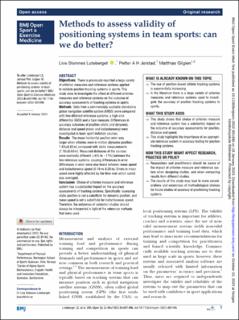| dc.contributor.author | Luteberget, Live Steinnes | |
| dc.contributor.author | Jølstad, Petter Andre Husevåg | |
| dc.contributor.author | Gilgien, Matthias | |
| dc.date.accessioned | 2023-10-23T12:27:24Z | |
| dc.date.available | 2023-10-23T12:27:24Z | |
| dc.date.created | 2023-04-11T20:38:34Z | |
| dc.date.issued | 2023 | |
| dc.identifier.citation | BMJ Open Sport & Exercise Medicine. 2023, 9(1), Artikkel e001496. | en_US |
| dc.identifier.issn | 2055-7647 | |
| dc.identifier.uri | https://hdl.handle.net/11250/3098108 | |
| dc.description | This is an open access article distributed in accordance with the Creative Commons Attribution Non Commercial (CC BY-NC 4.0) license, which permits others to distribute, remix, adapt, build upon this work non-commercially, and license their derivative works on different terms, provided the original work is properly cited, appropriate credit is given, any changes made indicated, and the use is non-commercial. | en_US |
| dc.description.abstract | Objectives: There is previously reported a large variety of criterion measures and reference systems applied to validate position tracking systems in sports. This study aims to investigate the effect of different criterion measures and reference systems on the outcome of accuracy assessments of tracking systems in sports.
Methods: Data from a commercially available standalone global navigation satellite system (GNSS) were compared with two different reference systems: a high-end differential GNSS and a tape measure. Differences in accuracy outcomes of position (static and dynamic), distance and speed (mean and instantaneous) were investigated in team sport imitation courses.
Results: The mean horizontal position error was larger when athletes were in motion (dynamic position; 1.53±0.82 m) compared with static measurements (1.10±0.60 m). Measured distances of the courses were markedly different (+6% to −17%) between the two reference systems, causing differences in error. Differences in error were also found between mean speed and instantaneous speed (0.10 vs 0.28 m). Errors in mean speed were highly affected by the time over which speed was averaged.
Conclusion: Choice of criterion measure and reference system has a substantial impact on the accuracy assessments of tracking systems. Specifically, assessing static position is not a substitute for dynamic position, and mean speed is not a substitute for instantaneous speed. Therefore, the outcomes of validation studies should always be interpreted in light of the reference methods that were used. | en_US |
| dc.language.iso | eng | en_US |
| dc.subject | assessing physiological demands of physical activity | en_US |
| dc.subject | exercise testing | en_US |
| dc.subject | method | en_US |
| dc.subject | speed | en_US |
| dc.subject | validity | en_US |
| dc.title | Methods to assess validity of positioning systems in team sports: Can we do better? | en_US |
| dc.type | Peer reviewed | en_US |
| dc.type | Journal article | en_US |
| dc.description.version | publishedVersion | en_US |
| dc.rights.holder | © Author(s) (or their employer(s)) 2023 | en_US |
| dc.source.pagenumber | 9 | en_US |
| dc.source.volume | 9 | en_US |
| dc.source.journal | BMJ Open Sport & Exercise Medicine | en_US |
| dc.source.issue | 1 | en_US |
| dc.identifier.doi | 10.1136/bmjsem-2022-001496 | |
| dc.identifier.cristin | 2140098 | |
| dc.description.localcode | Institutt for fysisk prestasjonsevne / Department of Physical Performance | en_US |
| dc.source.articlenumber | e001496 | en_US |
| cristin.ispublished | true | |
| cristin.fulltext | original | |
| cristin.qualitycode | 1 | |
